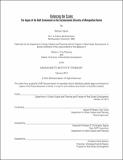Balancing the scales : the impact of the built environment on the socioeconomic diversity of Metropolitan Boston
Author(s)
Kaplan, Michael (Michael Lee)
DownloadFull printable version (93.22Mb)
Alternative title
Impact of the built environment on the socioeconomic diversity of Metropolitan Boston
Other Contributors
Massachusetts Institute of Technology. Center for Real Estate. Program in Real Estate Development.
Advisor
Terry Szold.
Terms of use
Metadata
Show full item recordAbstract
The question that this thesis ponders is: Is there a physical neighborhood form that promotes more integrated communities by supporting the different living preferences and resources of diverse racial and class groups? Though there are many factors that influence the socioeconomic diversity of a neighborhood, this study tests the hypothesis that a balanced urban environment-one that includes the characteristics of both city and suburb-is the most conducive neighborhood design to generate diverse communities. Residents' preferences for neighborhood style, location, and housing vary depending on need, resources, culture, and place in life. The city and the suburbs both offer different locations, housing options, and urban design that appeal and are available to different types of individuals. A balanced urban environment is one that spans both realms and offers a lifestyle that merges these two preferences together. A community that is able to provide a wider range of both urban and suburban options is likely to be more attractive, both financially and emotionally, to a broader spectrum of people, and thus more likely to be more socioeconomically diverse. Using metropolitan Boston as a case study, this thesis mapped socioeconomic diversity, defined as an equal mix of races and income classes, in the region. The author then visited the top eleven most diverse neighborhoods and identified two distinct neighborhood styles, the streetcar suburb and the affordable suburb, that promoted diversity. The observations from this fieldwork sparked three theories to explain why certain communities are more diverse than others: The Second Best Location Theory, the Affordable Walkability Theory, and the Personal Urbanism Theory. The observations also became the foundation for the thirteen variables that were developed to test these three theories empirically through a hedonic regression: distance to CBD; distance to transit; public transit usage; lot size; building density; density per dollar; walk score; walk score per dollar; presence of single family and small multifamily homes; and housing mix, size and tenure. The results of the regression confirm that diverse communities exhibit a balance of physical factors, including multiple transportation options, moderate density, multiple housing choices, including both single family and detached multifamily homes, as well as a roughly equal proportion of renters and owners, which is influenced by the presence of a mix of housing types. Location to train stations was insignificant, leading to the discovery that bus service is more associated with diverse communities than rapid transit. Additionally, the built environment was much more significant in explaining diversity in the suburbs than in the city, while the diverse communities in the city are likely caused by gentrification taking place around transit nodes. A hierarchy of the influence of urban form factors on diversity was also discovered, with small lots, a moderate density level, and public transit critical in setting a foundation for a mix of housing types and the presence of average sized homes. This study concludes by providing recommendations to improve the diversity of communities, including densifying suburban development, increasing bus service in the suburbs, preserving existing streetcar suburbs in cities, instilling more community control over public spaces in the city, and attempting to change the development of metropolitan regions to follow the balanced pattern of the dense urban suburbs.
Description
Thesis: M.C.P., Massachusetts Institute of Technology, Department of Urban Studies and Planning, 2014. Thesis: S.M. in Real Estate Development, Massachusetts Institute of Technology, Program in Real Estate Development in conjunction with the Center for Real Estate, 2014. Cataloged from PDF version of thesis. Includes bibliographical references (pages 157-165).
Date issued
2014Department
Massachusetts Institute of Technology. Center for Real Estate. Program in Real Estate Development.; Massachusetts Institute of Technology. Center for Real Estate; Massachusetts Institute of Technology. Department of Urban Studies and PlanningPublisher
Massachusetts Institute of Technology
Keywords
Urban Studies and Planning., Center for Real Estate. Program in Real Estate Development.